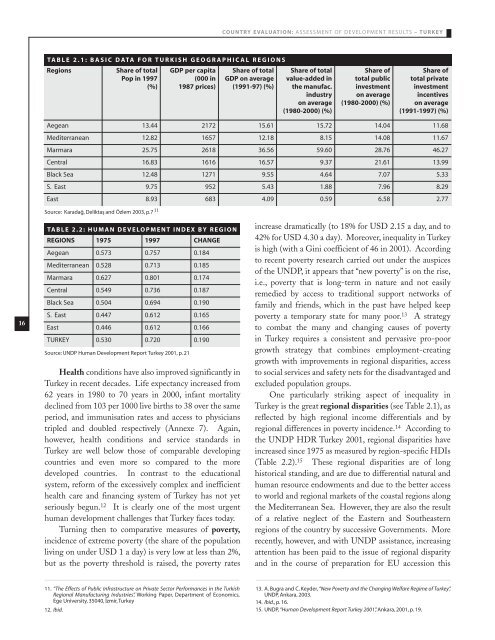Reports - United Nations Development Programme
Reports - United Nations Development Programme
Reports - United Nations Development Programme
Create successful ePaper yourself
Turn your PDF publications into a flip-book with our unique Google optimized e-Paper software.
COUNTRY EVALUATION: ASSESSMENT OF DEVELOPMENT RESULTS – TURKEY<br />
TABLE 2.1: BASIC DATA FOR TURKISH GEOGRAPHICAL REGIONS<br />
Regions<br />
Share of total<br />
Pop in 1997<br />
(%)<br />
GDP per capita<br />
(000 in<br />
1987 prices)<br />
Share of total<br />
GDP on average<br />
(1991-97) (%)<br />
Share of total<br />
value-added in<br />
the manufac.<br />
industry<br />
on average<br />
(1980-2000) (%)<br />
Share of<br />
total public<br />
investment<br />
on average<br />
(1980-2000) (%)<br />
Share of<br />
total private<br />
investment<br />
incentives<br />
on average<br />
(1991-1997) (%)<br />
16<br />
Aegean 13.44 2172 15.61 15.72 14.04 11.68<br />
Mediterranean 12.82 1657 12.18 8.15 14.08 11.67<br />
Marmara 25.75 2618 36.56 59.60 28.76 46.27<br />
Central 16.83 1616 16.57 9.37 21.61 13.99<br />
Black Sea 12.48 1271 9.55 4.64 7.07 5.33<br />
S. East 9.75 952 5.43 1.88 7.96 8.29<br />
East 8.93 683 4.09 0.59 6.58 2.77<br />
Source: Karadağ, Deliktaş and Özlem 2003, p.7 11<br />
TABLE 2.2: HUMAN DEVELOPMENT INDEX BY REGION<br />
REGIONS 1975 1997 CHANGE<br />
Aegean 0.573 0.757 0.184<br />
Mediterranean 0.528 0.713 0.185<br />
Marmara 0.627 0.801 0.174<br />
Central 0.549 0.736 0.187<br />
Black Sea 0.504 0.694 0.190<br />
S. East 0.447 0.612 0.165<br />
East 0.446 0.612 0.166<br />
TURKEY 0.530 0.720 0.190<br />
Source: UNDP Human <strong>Development</strong> Report Turkey 2001, p. 21<br />
Health conditions have also improved significantly in<br />
Turkey in recent decades. Life expectancy increased from<br />
62 years in 1980 to 70 years in 2000, infant mortality<br />
declined from 103 per 1000 live births to 38 over the same<br />
period, and immunisation rates and access to physicians<br />
tripled and doubled respectively (Annexe 7). Again,<br />
however, health conditions and service standards in<br />
Turkey are well below those of comparable developing<br />
countries and even more so compared to the more<br />
developed countries. In contrast to the educational<br />
system, reform of the excessively complex and inefficient<br />
health care and financing system of Turkey has not yet<br />
seriously begun. 12 It is clearly one of the most urgent<br />
human development challenges that Turkey faces today.<br />
Turning then to comparative measures of poverty,<br />
incidence of extreme poverty (the share of the population<br />
living on under USD 1 a day) is very low at less than 2%,<br />
but as the poverty threshold is raised, the poverty rates<br />
increase dramatically (to 18% for USD 2.15 a day, and to<br />
42% for USD 4.30 a day). Moreover, inequality in Turkey<br />
is high (with a Gini coefficient of 46 in 2001). According<br />
to recent poverty research carried out under the auspices<br />
of the UNDP, it appears that “new poverty” is on the rise,<br />
i.e., poverty that is long-term in nature and not easily<br />
remedied by access to traditional support networks of<br />
family and friends, which in the past have helped keep<br />
poverty a temporary state for many poor. 13 A strategy<br />
to combat the many and changing causes of poverty<br />
in Turkey requires a consistent and pervasive pro-poor<br />
growth strategy that combines employment-creating<br />
growth with improvements in regional disparities, access<br />
to social services and safety nets for the disadvantaged and<br />
excluded population groups.<br />
One particularly striking aspect of inequality in<br />
Turkey is the great regional disparities (see Table 2.1), as<br />
reflected by high regional income differentials and by<br />
regional differences in poverty incidence. 14 According to<br />
the UNDP HDR Turkey 2001, regional disparities have<br />
increased since 1975 as measured by region-specific HDIs<br />
(Table 2.2). 15 These regional disparities are of long<br />
historical standing, and are due to differential natural and<br />
human resource endowments and due to the better access<br />
to world and regional markets of the coastal regions along<br />
the Mediterranean Sea. However, they are also the result<br />
of a relative neglect of the Eastern and Southeastern<br />
regions of the country by successive Governments. More<br />
recently, however, and with UNDP assistance, increasing<br />
attention has been paid to the issue of regional disparity<br />
and in the course of preparation for EU accession this<br />
————————————————————————————————————<br />
11. “The Effects of Public Infrastructure on Private Sector Performances in the Turkish<br />
Regional Manufacturing Industries”, Working Paper, Department of Economics,<br />
Ege University, 35040, I˚zmir, Turkey<br />
12. Ibid.<br />
————————————————————————————————————<br />
13. A. Bugra and C. Keyder, “New Poverty and the Changing Welfare Regime of Turkey”,<br />
UNDP, Ankara, 2003.<br />
14. Ibid., p. 16.<br />
15. UNDP, “Human <strong>Development</strong> Report Turkey 2001”, Ankara, 2001, p. 19.

















